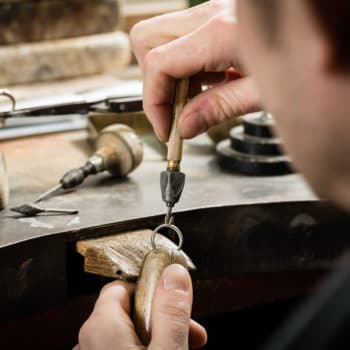Why We Love It
-
$31,690Potential Avg. Salary
-
-6%Job Growth Rate
-
Creativity FocusedCareer Attribute
-
Office Work EnvironmentCareer Attribute
A potter uses their creativity to design and craft functional pieces such as pots, vases, mugs and dishes for everyday purpose or artistic use. To hone their craft, potters take decades to learn new techniques and ideas.
Recommended Schools
What is a Potter?
Duties
Potters perform a range of diverse functions involving materials like clay:
- Use a potter’s wheel, molds and carving tools to craft dishware, vases and other decorative items.
- Regularly use the kiln for baking the clay products once they are partially dry and shaped.
- Glaze and paint works of clay to give them a protective coating and hardened finish.
- Perform business-related duties such as distributing promotional items and handle transactions with various clients.
Day In The Life
On an average day, a potter is occupied by creating different products using clay. It is up to you to determine the type of clay to be used (i.e. stoneware, porcelain, earthenware) and the tools. Tools used include carving tools, kilns, pottery wheels, molds, etc. You must also monitor how long a product is in the kiln, so it can be taken out and painted or glazed as per requirements.
Potters mostly work independently and take up freelance projects, thus taking care of the business side of things is also a must. You have to maintain accurate records of all financial transactions and ensure sales at your store. Promoting your unique artwork and building a reputation will form an important aspect of your day. In addition, communicating clearly and effectively with customers will help drive sales. In case your products are displayed at other venues such as museums or art galleries, you will be arranging the transport to locations and create engaging write-ups for every piece.
Work Schedule And Typical Hours
Potters are mostly self-employed and have flexible hours based on their impending deadlines and workload. Those working in formal education such as art foundations, art museums or art galleries will have regular hours and work full-time.
Growth Of The Job
Potters can expect a 1% job growth between the years 2014 and 2024. There is significant competition expected for job opportunities at formal institutions like art galleries, studio showrooms and craft fairs. Better job prospects are also available for potters who choose to teach the art to others at elementary schools, colleges or universities. Those artists with superior talent and creativity will find the most promising job positions.
Typical Employers
This career path involves setting up one’s business independently. You will support your income with functions such as teaching in schools, displaying artwork in art studios/craft fairs/galleries and supplying pieces through merchants. Occasionally, you might work on commission by completing specific projects for small businesses and individual buyers. You can find full-time or part-time employment offers with Jersey Pottery, Pottery Barn, Farmhouse Pottery, Old Time Pottery, Rookwood Pottery, etc.
Recommended Schools
How To Become a Potter
Formal education is not a prerequisite for finding job opportunities in this sector. However, a post-secondary education like a high school diploma is advantageous. Some choose to take informal pottery classes or attend workshops hosted by pottery studios and community colleges. Such training can take a few days to many months.
An apprenticeship is another alternative to gain skills as a potter and increase job prospects with networking. You spend long hours working alongside an experienced master potter who shares with you their techniques of pottery making as well as business management. Apprenticeships are strenuous and can last up to 3 years.
There are many professionals who choose to hone their craft by pursuing a 4-year bachelor’s degree in a relevant subject such as ceramics. The most common degree option for people in this field is Fine Arts. A few potters also have a materials engineering degree. In either case, your studies will entail a core curriculum including foundations of art history and critique. You will have time to fine-tune your skillset by developing artwork based on different themes and materials. There are many universities and private art institutions that offer degrees in fine arts, with specialisation in ceramics.
To be successful, you must have a passion for working with your hands on a regular basis. You must also have advanced skills in understanding proportions and space, since that is necessary to create perfect pieces. Being good with people is helpful as you are spending much of your time interacting with potential customers, gallery owners, artists for building relationships. Attention to detail and a passion for art will also be assets for aspiring candidates in this field.
Potter Salary Data
We’ve provided you the following to learn more about this career. The salary and growth data on this page comes from recently published Bureau of Labor Statistics data while the recommendations and editorial content are based on our research.
National Anual Salary
Low Range
$23,610Average
$31,690High Range
$47,330National Hourly Wage
Low Range
$11/hrAverage
$15/hrHigh Range
$23/hrHow do Potter salaries stack up to other jobs across the country? Based on the latest jobs data nationwide, Potter's can make an average annual salary of $31,690, or $15 per hour. This makes it an Above Average Salary. On the lower end, they can make $23,610 or $11 per hour, perhaps when just starting out or based on the state you live in.
Salary Rankings And Facts
#674 Nationally for All Careers
Highest Education Among Potters
- 0.3% Doctorate
- 3.2% Masters
- 10% Bachelors
- 4.4% Associates
- 20% College
- 31.6% High School
- 30.4% Less than High School
Job Growth Projections and Forecast
2014 Total Jobs
41,4002024 Est. Jobs
38,900Job Growth Rate
-6%Est. New Jobs
-2,500How does Potter job growth stack up to other jobs across the country? By 2024, there will be a change of -2,500 jobs for a total of 38,900 people employed in the career nationwide. This is a -6% change in growth over the next ten years, giving the career a growth rate nationwide of Below Average.
Growth Rankings And Facts
#715 Nationally for All Careers
What Companies Employ The Most Potters
| Industry | Current Jobs | New Jobs Needed | % Increase |
|---|---|---|---|
| Cement and concrete product manufacturing | 11,800 | -300 | 0% |
| Self-employed workers | 6,700 | -800 | -1% |
| Glass and glass product manufacturing | 3,400 | -800 | -1% |













